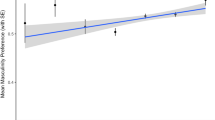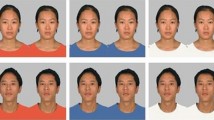Abstract
This study extends the scope of research that examines the connection between physical attractiveness and student perception through a survey analysis. While other studies concentrate on physical attractiveness alone, we examined not only perceptions of attractiveness but its impact on students’ perception of knowledge, approachability and faculty selection in a hypothetical course. Using ordered logistic regression, logistic regression and ordinary least squares regression to examine the interaction between age, attractiveness, knowledge and approachability, our findings show that younger faculty members are perceived as more approachable and more attractive, while older faculty members are perceived as more knowledgeable. Faculty perceived as more attractive are also perceived to be more approachable. Further, we test the impact that these results have on faculty selection in a hypothetical course and find that students are more likely to select an attractive and approachable faculty member to take a course with, regardless of perceived knowledge of the faculty member. Overall, although the perception of beauty may be cursory, its results may not be when considering the primacy effect, role model effect and teaching effectiveness assessment.

Similar content being viewed by others
Notes
We recognize that having only two categories for race is not ideal within the USA; however, our student sample did not have enough minority (or non-White) students to analyze the data with multiple racial categories.
Separate analyses were conducted for Group 1 and Group 2, but statistically significant differences were not found, so we combined both groups for the rest of the analysis section.
Distance between attractiveness scores was used since our pairs contain equally perceived attractive faculty as well as pairs with one faculty on the high end of the perceived attractiveness scale and one of the low end of the perceived attractiveness scale.
References
Ambady, N., & Rosenthal, R. (1993). Half a minute: Predicting teacher evaluations from thin slices of nonverbal behavior and physical attractiveness. Journal of Personality and Social Psychology, 64(3), 431–441.
Babad, E. (2001). Students’ course selection: Differential consideration for the first and last course. Research in Higher Education, 42(4), 469–492.
Babad, E., Darley, J. M., & Kaplowitz, H. (1999). Developmental aspects in students’ course selection. Journal of Educational Psychology, 91(1), 157–168.
Babad, E., Icekson, T., & Yelinek, Y. (2007). Antecedents and correlates of course cancellation in a university “drop and add” period. Research in Higher Education, 49, 293–316.
Basow, S. A. (2000). Best and worst professors: Gender patterns in students’ choices. Sex Roles, 43, 407–417.
Basow, S. A., Phelan, J. E., & Capotosto, L. (2008). Gender patterns in college students’ choices of their best and worst professors. Psychology of Women Quarterly, 30, 26–35.
Blackwell, J. E. (1981). Mainstreaming outsiders: The production of Black professionals. Bayside, NY: General Hall.
Boice, R. (1992). Countering common misbeliefs about student evaluation of teaching. ADE Bulletin, 1010(Spring), 2–8.
Borgida, E. (1978). Scientific deduction—Evidence is not necessarily informative: A reply to Wells and Harvey. Journal of Personality and Social Psychology, 36(5), 477–482.
Cashin, W. E. (1995). Student ratings of teaching: The research revisited. Idea paper no. 32. Center for Faculty Evaluation and Development, Division of Continuing Education, Kansas State University.
Clayson, D. E. (1999). Students’ evaluation of teaching effectiveness: Some implication of stability. Journal of Marketing Education, 21(1), 69–75.
Clayson, D. E., & Haley, D. A. (1990). Student evaluations in marketing: What is actually being measured? Journal of Marketing Education, 12(3), 9–17.
Clayson, D. E., & Sheffet, M. J. (2006). Personality and the student evaluation of teaching. Journal of Marketing Education, 28(2), 149–160.
Clifford, M. M., & Walster, E. (1973). The effect of physical attractiveness on teacher expectations. Sociology of Education, 46, 248–258.
Coleman, J., & McKeachie, W. J. (1982). Effects of instructor/course evaluations on student course selection. Journal of Educational Psychology, 73(2), 224–226.
Felder, R. M. (1995). What do they know anyway? Chemical Engineering Education, 26(3), 134–135.
Feldman, K. A. (1983). Seniority and experience of college teachers as related to evaluations they receive from students. Research in Higher Education, 18(1), 3–124.
Feldman, K. A. (1986). The perceived instructional effectiveness of college teachers as related to their personality and attitudinal characteristics: A review and synthesis. Research in Higher Education, 24(2), 139–213.
Felton, J., Koper, P. T., Mitchell, J., & Stinson, M. (2008). Attractiveness, easiness and other issues: Student evaluations of professors on Ratemyprofessor.com. Assessment & Evaluation in Higher Education, 33(1), 45–61.
Felton, J., Mitchell, J., & Stinson, M. (2004). Web-based student evaluations of professors: The relations between perceived quality, easiness and sexiness. Assessment & Evaluation in Higher Education, 29(1), 91–108.
Freeman, H. R. (1994). Student evaluations of college instructors: Effects of type of course taught, instructor gender and gender role, and student gender. Journal of Educational Psychology, 86(4), 627–630.
Freng, S., & Webber, D. (2009). Turning up the heat on online teaching evaluations: does “hotness” matter? Teaching of Psychology, 36, 189–193.
Fries, C. J., & McNingh, R. J. (2003). Signed versus unsigned student evaluations of teaching: A comparison. Teaching Sociology, 31(3), 333–344.
Glick, P., Larsen, S., Johnson, C., & Branstiter, H. (2005). Evaluations of sexy women in low- and high-status jobs. Psychology of Women Quarterly, 25, 389–395.
Godfrey, C. J. (2005). African American nursing faculty: where are they? The ABNF Journal, 16(1), 11–13.
Goebel, B. L., & Cashen, V. M. (1979). Age, sex and attractiveness as factors in student ratings of teachers: A developmental study. Journal of Educational Psychology, 71(5), 646–653.
Gump, S. E. (2007). Student evaluations of teaching effectiveness and the leniency hypothesis: A literature review. Educational Research Quarterly, 30(3), 55–68.
Hammermesh, D. S., & Parker, A. (2005). Beauty in the classroom: Instructors’ pulchritude and putative pedagogical productivity. Economics of Education Review, 24, 369–376.
Hewett, L. J., Chastain, G., & Thurber, S. (1988). Course evaluations: Are students’ ratings dictated by first impressions? Paper presented at the Rocky Mountain Psychological Association, April 21–22. Utah: Snowbird.
Hickson, J. (1993). Differences in influence of physical attractiveness on evaluations of leadership behavior for men and women in higher education. Journal for Higher Education Management, 9(1), 65–74.
Joseph, W. B. (1982). The credibility of physically attractive communicators: A review. Journal of Advertising, 11(3), 15–24.
Krautman, A. C., & Sander, W. (1999). Grades and student evaluations of teachers. Economics of Education Review, 18, 59–63.
Liddle, B. J. (1997). Coming out in class: Disclosure of sexual orientation and teaching evaluations. Teaching of Psychology, 24(1), 32–35.
Marks, R. B. (2000). Determinants of student evaluations of global measures of instructor and course value. Journal of Marketing Education, 22(2), 108–119.
Marsh, H. W., & Hocevar, D. (1991). Students’ evaluation of teaching effectiveness: The stability and mean rating of the same teachers over a 13-year period. Teaching and Teaching Education, 7(1), 303–314.
Marsh, H. W., & Roche, L. A. (1997). Making students’ evaluations of teaching effectiveness effective: The critical issues of validity, bias, and utility. American Psychologist, 52(11), 1187–1197.
McKeachie, W. J. (1997). Student ratings: The validity of use. American Psychologist, 52(11), 1218–1225.
Milliron, V. C. (2008). Exploring millennial student values and societal trends: Accounting course selection preferences. Issues in Accounting Education, 23(3), 405–419.
Murray, H. G. (1975). Predicting student ratings of college teaching from peer ratings of personality types. Teaching of Psychology, 2, 66–70.
Ortineau, D. J., & Bush, R. P. (1987). The propensity of college students to modify course expectations and its impact on course performance information. Journal of Marketing Education, 9, 42–52.
Otto, J., Sanford, D. A, Jr, & Ross, D. N. (2008). Does ratemyprofessor.com really rate my professor? Assessment & Evaluation in Higher Education, 33(4), 355–368.
Rask, K. N., & Bailey, E. M. (2002). Are faculty role models? Evidence from major choice in an undergraduate institution. Journal of Economic Education, 33(2), 99–124.
Riggle, E. D., Ottati, V. C., Wyer, R. S., Kuklinski, J., & Schwarz, N. (1992). Basis of political judgements: The role of stereotypic and nonstereotypic information. Political Behavior, 14(1), 67–87.
Riniolo, T. C., Johnson, K. C., Sherman, T. R., & Misso, J. A. (2006). Hot or not: Do professors perceived as physically attractive receive higher educations? Journal of General Psychology, 133(1), 19–35.
Ritter, J. M., Casey, R. J., & Langlois, J. H. (1991). Adults’ responses to infants varying in appearance of age and attractiveness. Child Development, 62(1), 68–82.
Sauber, M. H., & Ludlow, R. R. (1988). Student evaluation stability in marketing: The importance of early class meetings. The Journal of Midwest Marketing, 3(1), 41–49.
Sebastian, R. J., & Bristow, D. (2008). Formal or informal? The impact of style of dress and forms of address on business students’ perception of professor. Journal of Education for Business, 83(4), 196–201.
Sherman, B. R., & Blackburn, R. T. (1975). Personal characteristics and teaching of college faculty. Journal of Educational Psychology, 67(1), 124–131.
Sigelman, L., Sigleman, C. K., & Fowler, C. (1987). A bird of a different feather? An experimental investigation of physical attractiveness and the electability of female candidates. Social Psychology Quarterly, 50, 32–43.
Smith, B. P. (2009). Student ratings of teaching effectiveness for faculty groups based on race and gender. Education, 129(4), 615–624.
Takeshita, T., & Maeda, K. (1999). An integrated web computing application for tasks related to course selection and registration. Information and Software Technology, 41, 955–1004.
Wapnick, J., Mazza, J. K., & Darrow, A. A. (2000). Effects of performer attractiveness stage behavior and dress on evaluation of childrens’ piano performances. Journal of Research in Music Education, 48(4), 323–335.
Wilhelm, W. C. (2004). The relative influence of published teaching evaluations and other instructor attributes on course choice. Journal of Marketing Education, 27(1), 17–30.
Zabaleta, F. (2007). The use and misuse of student evaluations of teaching. Teaching in Higher Education, 12(1), 55–76.
Author information
Authors and Affiliations
Corresponding author
Rights and permissions
About this article
Cite this article
Mendez, J.M., Mendez, J.P. Student inferences based on facial appearance. High Educ 71, 1–19 (2016). https://doi.org/10.1007/s10734-015-9885-7
Published:
Issue Date:
DOI: https://doi.org/10.1007/s10734-015-9885-7




